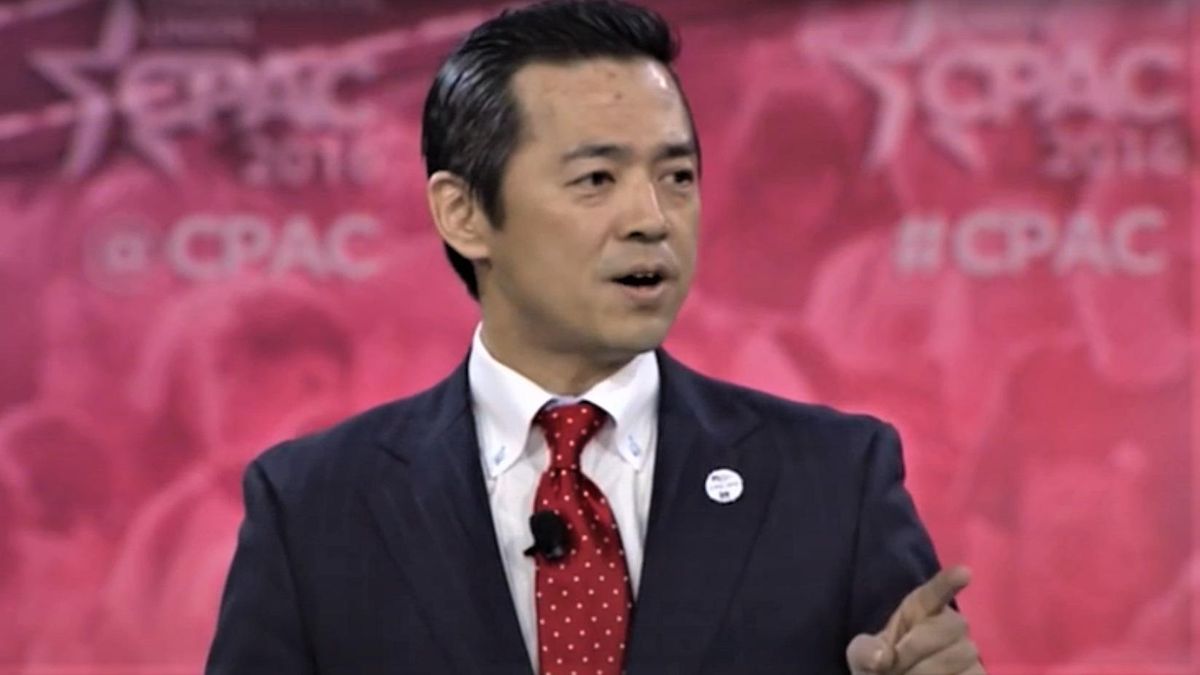Here's how white evangelicals found themselves worshipping a golden Trump
John Stoehr, The Editorial Board RAW STORY
February 26, 2021

Social media was ablaze this morning with a video taken at the Conservative Political Action Conference in Washington of a golden statue in the image of Donald Trump. People right away associated the graven image with the golden calf of the Bible—when Moses took so long bringing Yahweh's Law down from Mt. Sinai that his brother succumbed to pressure to erect an idol to a competing god. "Mentioned in Exodus 32 and I Kings 12 in the Old Testament, worship of the golden calf is seen as a supreme act of apostasy, the rejection of a faith once confessed," according to the Encyclopedia Britannica. "The figure is probably a representation of the Egyptian bull god Apis in the earlier period and of the Canaanite fertility god Baal in the latter.
Now, there's more important stuff going on right now. The parliamentarian of the United States Senate, for instance, ruled last night that the provision in the president's covid relief package that raises the federal minimum wage to $15 an hour cannot pass by way of "reconciliation," which is a special budget rule requiring a simple majority instead of the usual 60 votes. That, plus the reluctance of Joe Manchin and Kyrsten Sinema to monkey with the rule, means the hard work of governance is becoming visible. By comparison, a statue of "the Golden Ass," as someone quipped, seems rather petty. I disagree. This image captures something important and dire about the forces that still threaten our republic. It's worth our time thinking about them.
Why are white evangelical Protestants so obedient to authority?
I think because it's literally beaten into them.
Let's start with the obvious. Trump's most reliable supporters are white evangelical Protestants (WEPs). These are the people who are most likely to attend this weekend's Conservative Political Action Conference. You'd think, given how devoutly religious the former president's supporters claim to be, that they would be outraged by the sight of a golden statue in Trump's image, an idol akin to the golden calf, a graven image for worshipping a competing god. You'd think WEPs would be discomfited even by the appearance of elevating a mere mortal (Donald Trump) to the level of the Almighty.
I've explained many times before how two things that should not co-exist find a way of co-existing. But I have not explained one of the psychological roots of this cognitive dissonance. The reason WEPs can look at a statue of Donald Trump and not be overly vexed with worry that they might be worshipping a competing God is because their leaders said it was OK. What Franklin Graham, Jerry Falwell Jr and others say matters a lot to these people, because for nearly all of them obedience to authority is the same thing as morality. Whose authority? That of the leaders of the One Truth Faith, of course. Why are WEPs so obedient? I think because it's literally beaten into them.

Violence is what I'm talking about. Specifically, violence committed against children for the purpose of breaking their wills in order to save their souls from an eternity of burning in a Lake of Fire. This is often called "spanking," but spanking sounds almost fun. (For some people, it is fun!) "Spanking" or its clinical counterpart, "corporal punishment," do not capture fully a child's experience of enduring pain at the hands of someone whom they cannot stop loving. Trust me when I say the unconditional love of a child for a parent means the child will surrender his will for the sake of that love. There is no alternative in a violent setting, except the alternative of psychic death.

With the understanding that violence is the same thing as love, the child is ready to accept anything—and I really mean anything. Critics of white evangelical Protestants do not, and perhaps cannot, appreciate how bottomless the desire is among WEPs to believe anything, even when it profoundly conflicts with their own stated religious convictions. If a WEP leader says it's OK to have around a golden statue of a former president venerated by their community, then it's OK. Full stop. There is no discussion among the vast majority of the tens of millions of WEPs who idolize Donald Trump.
February 26, 2021

Social media was ablaze this morning with a video taken at the Conservative Political Action Conference in Washington of a golden statue in the image of Donald Trump. People right away associated the graven image with the golden calf of the Bible—when Moses took so long bringing Yahweh's Law down from Mt. Sinai that his brother succumbed to pressure to erect an idol to a competing god. "Mentioned in Exodus 32 and I Kings 12 in the Old Testament, worship of the golden calf is seen as a supreme act of apostasy, the rejection of a faith once confessed," according to the Encyclopedia Britannica. "The figure is probably a representation of the Egyptian bull god Apis in the earlier period and of the Canaanite fertility god Baal in the latter.
Now, there's more important stuff going on right now. The parliamentarian of the United States Senate, for instance, ruled last night that the provision in the president's covid relief package that raises the federal minimum wage to $15 an hour cannot pass by way of "reconciliation," which is a special budget rule requiring a simple majority instead of the usual 60 votes. That, plus the reluctance of Joe Manchin and Kyrsten Sinema to monkey with the rule, means the hard work of governance is becoming visible. By comparison, a statue of "the Golden Ass," as someone quipped, seems rather petty. I disagree. This image captures something important and dire about the forces that still threaten our republic. It's worth our time thinking about them.
Why are white evangelical Protestants so obedient to authority?
I think because it's literally beaten into them.
Let's start with the obvious. Trump's most reliable supporters are white evangelical Protestants (WEPs). These are the people who are most likely to attend this weekend's Conservative Political Action Conference. You'd think, given how devoutly religious the former president's supporters claim to be, that they would be outraged by the sight of a golden statue in Trump's image, an idol akin to the golden calf, a graven image for worshipping a competing god. You'd think WEPs would be discomfited even by the appearance of elevating a mere mortal (Donald Trump) to the level of the Almighty.
I've explained many times before how two things that should not co-exist find a way of co-existing. But I have not explained one of the psychological roots of this cognitive dissonance. The reason WEPs can look at a statue of Donald Trump and not be overly vexed with worry that they might be worshipping a competing God is because their leaders said it was OK. What Franklin Graham, Jerry Falwell Jr and others say matters a lot to these people, because for nearly all of them obedience to authority is the same thing as morality. Whose authority? That of the leaders of the One Truth Faith, of course. Why are WEPs so obedient? I think because it's literally beaten into them.

Violence is what I'm talking about. Specifically, violence committed against children for the purpose of breaking their wills in order to save their souls from an eternity of burning in a Lake of Fire. This is often called "spanking," but spanking sounds almost fun. (For some people, it is fun!) "Spanking" or its clinical counterpart, "corporal punishment," do not capture fully a child's experience of enduring pain at the hands of someone whom they cannot stop loving. Trust me when I say the unconditional love of a child for a parent means the child will surrender his will for the sake of that love. There is no alternative in a violent setting, except the alternative of psychic death.

With the understanding that violence is the same thing as love, the child is ready to accept anything—and I really mean anything. Critics of white evangelical Protestants do not, and perhaps cannot, appreciate how bottomless the desire is among WEPs to believe anything, even when it profoundly conflicts with their own stated religious convictions. If a WEP leader says it's OK to have around a golden statue of a former president venerated by their community, then it's OK. Full stop. There is no discussion among the vast majority of the tens of millions of WEPs who idolize Donald Trump.
I do not mean to portray these people as monolithic or as robots. There is plenty of disagreement within the WEP community. And I do not mean to portray these people as savaging their own kids. There are plenty of ways of "disciplining" children without violating the letter of laws that prohibit child abuse. I do mean, however, to convey the imminent danger we face. It's too easy to ghettoize WEPs—to say they are a cult separate from the larger body of believers. "Cult" strains credulity when we're talking about tens of millions primed from a young age to believe that the reality they inhabit is a shadow of a "real" reality and that access to that "real" reality requires that they repudiate the reality that everyone outside of their community actually inhabits.
Violence begets lies begets attempts to not only compete with reality but replace it. Violence begets lies begets attempts to force the rest of us to surrender our wills and our understanding of the reality we inhabit and live inside their lie. That's what I see when I see WEPs taking selfies next to a new Golden Calf. You should see it, too.
Violence begets lies begets attempts to not only compete with reality but replace it. Violence begets lies begets attempts to force the rest of us to surrender our wills and our understanding of the reality we inhabit and live inside their lie. That's what I see when I see WEPs taking selfies next to a new Golden Calf. You should see it, too.











